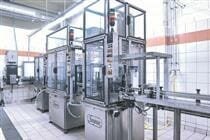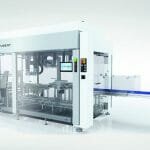Producing high quality champagne takes time and expertise; ensuring consistent quality requires precision process control and a reliable infrastructure. For CRVC (Coopérative Régionales des Vins de Champagne) the installation of a special disgorging line required expert support, which was delivered through a partnership with Bürkert.
![]()
The process of creating good champagne takes many years of experience to perfect and the final taste is dependent on a number of factors, not least the addition of the ‘dosage’ which replaces liquid lost when the yeast residue is removed. As one of the last processes before the champagne is stored and then sold, achieving precision and reliability in this procedure is vital to defining the quality of the finished product.
Creating the taste
Once champagne has gone through its second fermentation, the bottles are laid down to age in such a way that any yeast sediment collects in the neck of the bottle. After ageing, the bottles are processed through a machine that freezes the neck, capturing the yeast residue in a plug of ice below the temporary cork.
Each bottle is then opened and the gas pressure in the bottle ejects the ice plug and a small amount of the champagne; this process is known as disgorging. To replace the lost champagne, a small amount of wine and cane sugar, the ‘dosage’, is added to each bottle. The composition of this special mixture is specified by the wine-maker and it contributes to the champagne’s ultimate specific flavour and sweetness.
Meeting the challenge
As part of a continued expansion of its manufacturing facilities, CRVC was looking to extend its disgorgement line and that included installing additional dosage equipment. However, the space required for the line meant that the dosing system and the dosing machine were located on different floors, increasing the technical difficulties associated with this project.
To ensure an efficient and effective solution was delivered, CRVC approached Bürkert to discuss the possibilities. Having completed a feasibility study, Bürkert engineers designed a solution and carried out trial runs to fine-tune the programming and ensure compatibility with the main process control infrastructure. All the work had to be completed without interfering with the normal operations of the production line.
David Vansuypeene, Account Manager for Bürkert, comments: “The fact that the dosage was stored almost 10 metres above the dosing machine had led to some issues with the process. One of the major concerns was the variable pressure in the dosage supply line, which was dependent on the amount of liquid in the tank. This led to variations in the amount being added to the bottles.”
Delivering the solution
At the heart of the design was the Type 8619 multiCELL transmitter/controller, which can be connected to a wide range of sensors to measure parameters such as flow rate, pH, ORP, temperature, pressure and conductivity. In addition, the versatile multiCELL can also be configured as a multipoint data logger with data storage on SD cards.
The controller is designed with a simple and intuitive user interface that requires minimal operator training. In conjunction with pressure sensors and a diaphragm valve, the controller was installed by CRVC technicians to complete the automation of the process.
The final step to fine-tune the programming and parameterisation was the most delicate and most important as this would define the taste of the champagne. During the testing phase, a great deal of collaborative work was completed to establish the correct settings for the dosage. Slightly reduced sugar levels for a crisp, dry brut and a fraction more sugar for the sweeter demi-sec or doux.
David Vansuypeene concludes: “Bürkert was able to complete the entire project without affecting the day-to-day running of the bottling process. Through close collaboration and effective management, we have delivered a successful installation that met all the objectives of the customer, including price. As a direct result of this work, we will be looking to install a Type 8056 flowmeter on the disgorging lines as well.”

The Type 8619 multiCELL controller can be connected to a wide range of sensors to measure parameters such as flow rate, pH, ORP, temperature and conductivity







